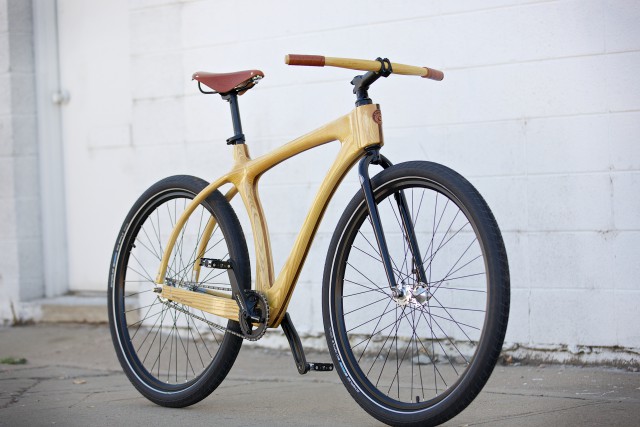
“I’ve been building things out of wood for a long time,” Chris Connor says when Boulder Weekly finally tracks him down. Connor, you see, is on a roll. A high-tech consultant who calls the Front Range home, he’s also a master craftsman. And then there was Thanksgiving with family in Idaho to attend to. Not to mention he also needs time to ride his bike.
Connor is about to become a lot busier. The unique bikes he creates are wooden pieces of art, combining the functionality of two-wheeled travel with the building techniques of instrument making, creating a fusion of form and function that is, ultimately, all about fun.
Cruiser bikes are, by their very nature, the kind of adult toy that makes everyone smile. Functional, practical and easy to ride, the cruiser is the ideal leveler. From hardcore endurance mountain bike racers to the middle-aged neighbor down the street, everyone can ride a cruiser.
“The bike is a hot rod cruiser,” Connor says of the unique wooden cycles he hand-manufactures in Colorado.
“They’re stylish and fast,” adds Brian Wilson, a bike shop veteran who has spent the last 15 years commuting 23 miles to work each day on a bike (unfortunately, he says, it’s not on a Connor bike).
The ride is, says Wilson, “a lot like skiing.”
“It is real smooth,” he says. “The wood absorbs every single vibration in the street, I’ve never felt anything like it in a bike.”
“I always wanted to build things out of wood,” says Connor, who admits to ending up in Colorado because he “chased a girl out to Boulder,” and who worked in high-tech marketing before deciding to pursue what he calls his true passion.
The opportunity didn’t come until 2006, when he moved to Massachusetts to assist his brother, Stephan, with a growing instrument manufacturing business.
“I convinced my wife to leave her job, sell the house, and we moved,” says Connor.
In Massachusetts, Stephan Connor was making high-end wood classical guitars, a business that he launched in 1994. With Chris’ experience in communications and business processes, the company was able to streamline processes and overhaul communications, becoming more profitable and efficient. But most importantly, Chris was able to work with wood.
Despite the burgeoning success of the guitar business, the Colorado lifestyle kept calling.
“After a couple of years of living back east, I knew I couldn’t stay there,” he says. Connor moved back to Colorado in 2008, looking to get sawdust up his sleeves.
“I was infected with the bug,” he says. “I knew that I could do consulting for high-tech companies in Colorado, but the real intent was to build, design and create with wood.”
Connor had already been building his own custom furniture, and his work with his brother had taught him that wood could take on more intimate relationships.
“I enjoyed making furniture,” he recalls. “But I had been searching for the same level of interaction that I had enjoyed with instruments.
“The wood took on a second life,” he says and laughs. “You can only interact with a chair or table so much.”
An enthusiastic cyclist, Connor started thinking about making bikes.
“When I was in Boulder, I had been an avid mountain biker,” says Connor. “About a year ago, I thought, ‘Wouldn’t it be fun to build a wooden bike?’ The idea flickered into my mind and passed on. Then I remembered it.”
The wooden bike idea was the kind of technical problem wrapped in artistry that appealed to Connor. He also liked that the solution to the problem had the potential to be one that allowed for an intimate relationship between the object and the user.
“Bikes have to be built to exacting standards, similar to guitars,” says Connor. “They are very precise, and there is also the same element of taking things out into the world with you. It’s not something that sits passively, you go and ride it around, and so the idea of building a bike intrigued me. And the idea also of building something that’s beautiful, with flowing lines. So it started making sense. You can make it strong, not everyone thinks that with wood you could build things that are very strong, but I knew I could make something beautiful and strong technically and precise, a culmination of all my interests.”
As Connor started to delve into the concept, he discovered that his skill set and interests — from cycling to woodworking to business acumen — were uniquely suited to solve the design problems and bring the concept to market.
“There are a lot of people who have done these things as novelty projects or design experiments, but only a handful of people are trying to do something for a market,” says Connor.
“There are examples of these things as art,” he adds. “But I want to reach a real-world audience.
“If you are going to call something a bike it has to be able to be ridden, has to be able to survive normal riding conditions, and be capable of being taken into the elements. It must function as a bike if you are going to call it a bike.”
There’s no doubt that when you look at a bike from Connor Cycles, it is meant to be ridden.
Using a combination of ash, Kevlar and epoxy, Connor steam-bends the wood, laminates the handlebars and creates a bicycle that is as tough as it is beautiful.
“I decided max strength is in [the rider’s] best interest,” says Connor. “I don’t think anyone is doing wood composite laminations to build bikes, and I was able to create incredibly strong assemblies. The wood flexes, but won’t come apart.”
Some people look at the handlebars, says Connor, “and they say, ‘That will turn into splinters in my hands.’ But I can drive my car on the handlebar. It supports the weight of the car. These assemblies can be incredibly strong, and to complement the strength, I tried to capitalize on the beauty of the wood, and make the curves flow together.”
The experiment, by anyone’s measure, has been a success. Connor’s bicycles are unlike anything you’ve ever seen. And they have a ride like no other.
“The ride is what you wind up with,” says Connor. “You get this incredible ride. It feels solid, it feels secure, but it is exceptionally smooth, unlike anything else. Every time I get on it and ride around with a big smile on my face, it is so smooth.”
“The intent is that it is someone’s second or third bike,” says Connor, who adds that a built-to-order frameset starts at $2,500, with ready-to-pedal-out-the-door-and-down-the-street models starting at $3,200.
“A high-end cruiser bike is $500,” says Connor. “But this is a different animal. It is art and it is function, so the price tag reflects that.”
And, according to Wilson and Connor, people know you’re riding something special.
“You’ll get a lot of questions,” says Wilson. “The bike really turns heads. The color of it is just a beautiful wooden color that you don’t see on a bike.”
“You get stares, comments, call outs,” adds Connor. “People see it and they know it is something special.”
Connor laughs. “They are not for someone who is shy. You will be noticed. The bikes are the red Ferrari that pulls up to the curb.”
Connor Cycles currently offers one model. The Woody 29er Scorcher is made of hand-sculpted ash and walnut; features 29-inch wheels, fat tires and a two-speed gearhub; and weighs 25 to 30 pounds, depending on the build. The bike comes in Small, Medium, Large and “Jumb0” sizing. Cost is $2,500/frameset to $3,300 for a fully built edition.
Visit www.connorcycles.com for more information, photos and videos.
Respond: [email protected]














